Methanol
-
- Marine Fuel of the Future: The Case for Methanol Maritime Reporter, Mar 2016 #20
The global shipping industry is facing increasingly stringent emissions requirements. As of January 1st , 2016, newbuild ships sailing in certain Emission Control Areas (ECAs) known as NOx Emission Control Areas (NCEAs), which currently comprise the North American and Caribbean Sea ECAs, are required to meet stringent ‘Tier III’ NOx emission standards. These Tier III standards require around 70% lower NOx emissions than the current Tier II standards and can’t be met simply by taking the sulfur out of fuel oil.2016’s implementation of Tier III NOx emission standards join 2015’s requirement that ships entering within 200 miles of US, Canadian, Caribbean and northern European waters began to face a 0.1% fuel-sulfur limit. National and regional environmental agencies in these areas had established Sulfur Emission Control Areas (SECAs) under pollution rules adopted by the International Maritime Organization (IMO). While shifting to low-sulfur marine gasoil (MGO) provided a viable, albeit expensive, compliance strategy with 2015’s sulfur regulations, it will not help to meet the new Tier III NOx reduction regulations.Potential solutions for the Tier III limits include Selective Catalytic Reduction (SCR) systems and Exhaust Gas Recirculation Systems (EGR), but these technologies are complicated, costly, and largely unproven.For the existing fleet of some 100,000 commercial vessels plying the world’s oceans, and the 2,000 new keels laid each year, the option of adding dual-fuel capability for diesel-LNG (liquefied natural gas) or diesel-methanol is increasingly seen as the smart course. While there are already some 50-60 ships using LNG as a bunker fuel, interest in the use of methanol fuel, as a considerably less expensive alternative to LNG, is quickly gaining speed.First, let’s look at the global efforts to demonstrate methanol as a marine engine fuel:● From 2010 to 2014, two European programs – EffShip (“Efficient Shipping with Low Emissions”) and SPIRETH (“Alcohol (Spirits) and Ethers as Marine Fuel) – identified methanol as an alternative fuel that could reduce emissions and improve the environmental performance of marine transport. The technology development work from these programs contributed to the IMO’s draft IGF code (International Code of Safety for Ships using Gases or Low-Flashpoint Fuels) which governs the safe handling of LNG and methanol fuels on-board ships.● In December 2013, Methanex Corporation, the world’s largest methanol producer and distributor, announced an agreement with Mitsui OSK Lines (MOL) to build seven new 50,000 dead weight ton ships with MAN Diesel & Turbo’s ME-LGI flex fuel engines running on methanol, fuel oil, marine diesel oil, or gas oil. The ships are being built for delivery next year by Japan’s Minaminippon Shipbuilding Co., and South Korea’s Hyundai Mipo Dockyards Ltd. The ships have been chartered by Canada’s Waterfront Shipping Company, a subsidiary of Methanex.● In January 2015, Lloyd’s Register announced plans to design a whole new generation of cruise ships and ro-pax ferries powered by methanol ushering in a low-emission, fuel-efficient revolution in today’s marine fleet. Partnering in the project are German shipyard Meyer Werft, German shipbuilder Flensburger-Schiffbau-Gesellschaft, and German methanol distributor HELM AG. Funded by the German government, designs for the new methanol ships will be developed over the next three years.● In March 2015, the Swedish ferry operator Stena Line, relaunched the Stena Germanica featuring the world’s first dual-fuel methanol propulsion system. The 240-meter long, 1,500 passenger ro-pax ferry features four Wärtsilä engines, with one of the engines converted to methanol operation while in dry dock in Poland’s Remontowa shipyard in January 2015. Having been satisfied with initial tests, the other three engines will now be converted one by one while the vessel is in service. Running on methanol, SOx emissions are expected to be cut by 99%, NOx by 60%, particulates by 95%, and CO2 by 25%. Funding of €11.2 million for the work was provided under the European Union’s Trans-European Transport Networks (TEN-T) program.A new report released by FCBI Energy in December 2015, and commissioned by the Methanol Institute (MI), details the many advantages of methanol. The report, Methanol as a Marine Fuel, contains a number of key findings and can be downloaded HERE.• Methanol is plentiful, available globally and could be 100% renewable - There are over 70 million tons of methanol being produced annually, and depending on the feedstock used in its production, it can be 100% renewable as well.• Current bunkering infrastructure needs only minor modifications to handle methanol – Methanol is very similar to current marine fuels such as heavy fuel oil (HFO) as it is also a liquid. Existing storage, distribution and bunkering infrastructure can handle methanol with only minor modifications necessary due to methanol being a low-flashpoint fuel.• Infrastructure costs are modest compared to alternative solutions – Installation costs of a small methanol bunkering unit have been estimated at around € 400,000, and a bunker vessel can be converted for approximately € 1.5 million. In contrast, an LNG terminal costs approximately € 50 million, and an LNG bunker barge € 30 million.• Conversion costs will drop dramatically as experience mounts – The main reference point on conversion costs comes from conversion of the Stena Germanica. Being the first of its kind, the Stena Germanica retrofit entailed much design work on new technical solutions, safety assessments and adaptation of rules and regulations. It has been estimated that a second retrofit will cost only 30% to 40% of the Stena Germanica conversion.• Current engines have performed well on methanol and upcoming technologies will further improve this performance – Thus far, methanol ships have been powered by diesel concept engines modified to run on both methanol and marine diesel. Converted methanol engines have performed as well as, or better than, diesel engines in both field and lab tests. Methanol-optimized engines currently in development are expected to perform even better than the current converted engines.• Shipping and chemical industries have a long history and ample experience in handling methanol safely – Methanol has been shipped globally, and handled and used in a variety of applications for more than 100 years. From a health and safety perspective, the chemical and shipping industries have developed tested procedures to handle methanol safely. These have been codified in the Methanol Safe Handling and Safe Berthing Bulletin and Checklists available on MI’s website HERE.• Methanol is biodegradable – From an environmental point of view, methanol performs well. Methanol dissolves rapidly in water and is biodegraded rapidly. In practice, this means that the environmental effects of a large spill would be much lower than from an equivalent oil spill.As the lifecycle economics, and other benefits of using methanol compared with other emission compliance options becomes more evident, we expect to see the tide rising on the use of methanol as a marine engine fuel.About the AuthorGreg Dolan serves as CEO of the Methanol Institute (MI), the global methanol industry trade association.As published in the March 2016 edition of Maritime Reporter & Enginering News (http://digitalmagazines.marinelink.com/nwm/MaritimeReporter/201603/) -
- IMO2020: Methanol Proves Promising Maritime Reporter, Dec 2019 #26
When the clock strikes midnight on December 31, 2019, the maritime world enters a bold new era of emission reduction. With its growing fleet of methanol fueled ship and more than 60,000 hours of operating experience under its belt, Waterfront Shipping Company has a five-year headstart.As a general
-
- Design Profile: Glosten's SA-100 Methanol-hybrid Tug Marine News, Feb 2023 #36
to improve efficiency and reduce emissions, and a wide range of new solutions are coming to market to answer the call. Among these is a new design for a methanol-hybrid tug from naval architecture and marine engineering firm Glosten. The SA-100, developed in collaboration with systems integrator ABB, is a high-power
-
- Report: Methanol a Viable Alternative Marine Fuel Maritime Reporter, Jan 2016 #11
Methanol has a “historic opportunity” as a marine fuel, according to a new report published by research group FCBI Energy. Despite having many attributes that make methanol an attractive, low-emissions marine fuel, it has sometimes been overlooked in policy and industry discussions, according to
-
- IMO2020: 4 Tips to Using Methanol as Fuel Maritime Reporter, Dec 2019 #29
Lessons learned on designing, building & operating with methanol as fuel.Generally averse to technological risk, maritime professionals lean on lessons learned, when available, to make future decisions. According to Fredrik Stübner, Director Ship Management, Marinvest, his organization’s experience running
-
- MAN ES: Moving Forward on Ammonia Engines Maritime Reporter, Jan 2023 #18
to evolve too as LNG is not the fuel to get shipowners over the 2050 emissions hump. A broad array of new fuels – including SNG, biofuels, hydrogen, methanol and ammonia – are entering the mix as shipowners eye options that will enable them to more easily reach ever stricter emission and performance
-
- Conoco And Mitsui Group Verify Feasibility Of Floating Methanol Plant Maritime Reporter, May 15, 1977 #4
The technical and economic feasibility of a floating methanol plant has been verified in a joint study by Continental Oil Company (Conoco), High Ridge Park, Stamford, Conn. 06904, and a Tokyo group of Mitsui companies consisting of Mitsui & Co., Ltd., Toyo Engineering Corporation, and Mitsui
-
- Future Ship Fuels: Cut through the Smoke Maritime Reporter, Feb 2020 #20
potential in the short, medium and longer terms.Effectively, there are three fuel pathways to 2030 and beyond: The LNG, or ‘light gas’ pathway; the LPG/methanol (or alcohol) ‘heavy gas’ pathway; or the ‘bio/¬synthetic fuel’ pathway. None of these are mutually exclusive.The first two technology families already
-
- Great Ships of 2016: Lindanger Maritime Reporter, Dec 2016 #33
has recognized excellence in ship construction. This year 18 ships in total were honored, including many “world firsts.” Lindanger - World’s First Methanol Fueled Tanker Builder: Hyundai Mipo Dockyard Owner: Westfal-Larsen Launched at the Hyundai Mipo dockyard in Ulsan, South Korea, the newly built
-
- Alfa Laval: New Test Facilities, New Technologies Maritime Reporter, May 2017 #66
in the areas of ballast water treatment, sulfur oxide emission control, touchscreen boiler control, fuel efficiency automation for inert-gas systems and methanol booster systems. Alfa Laval, a global provider of specialized products and engineering solutions based on the key technologies of heat transfer
-
- Insights: Kunkel Weighs in on Propulsion Technology Marine News, Jul 2016 #12
LNG? Methanol as fuel? Hybrid systems? Tier 4? Reducing noise? Cutting emissions without crushing fuel economy? Marine News readers have questions and Bob Kunkel has answers. Kunkel, President of Alternative Marine Technologies, previously served as the Federal Chairman of the Short Sea Shipping Cooperative
-
- Insights: Robert Schluter, e1 Marine Marine News, Feb 2023 #08
, Irish tanker owner Ardmore Shipping and Schluter’s second startup, Bend, Ore.-based hydrogen generation specialist Element 1 Corp, supplies methanol-to-hydrogen generator technology for vessels as the maritime industry plots its course toward cleaner operations.With any new technology comes challenges
-
 )
April 2024 - Maritime Reporter and Engineering News page: 13
)
April 2024 - Maritime Reporter and Engineering News page: 13from gasoline to methanol, but compared to just buying an EV After some pondering, I think I can reduce it to this logi- today that is a pointless exercise. It would actually make more cal sequence: sense to buy a plug-in hybrid that is con? gured for methanol It is the carbon. We want zero carbon as
-
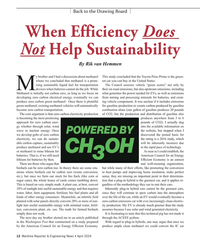 )
April 2024 - Maritime Reporter and Engineering News page: 12
)
April 2024 - Maritime Reporter and Engineering News page: 12Back to the Drawing Board When Efficiency Does Not Help Sustainability By Rik van Hemmen y brother and I had a discussion about methanol This study concluded that the Toyota Prius Prime is the green- where we concluded that methanol is a prom- est car you can buy in the United States. ising sustainable
-
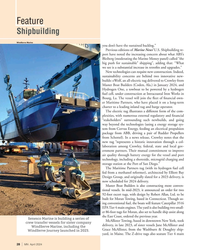 )
April 2024 - Marine News page: 28
)
April 2024 - Marine News page: 28a shoreside, microgrid charging and storage station at the Port of San Diego.” The Maritime Partners tug (with its hydrogen fuel cell fed from a methanol reformer), architected by Elliott Bay Design Group, and originally slated for a 2023 delivery, is now scheduled for 2024 delivery. Master Boat
-
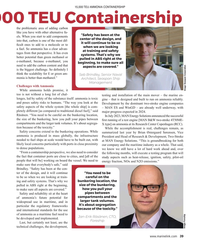 )
February 2024 - Maritime Reporter and Engineering News page: 39
)
February 2024 - Maritime Reporter and Engineering News page: 39fuel. So ammonia has a clear advan- at training and safety tages from that perspective. It has even systems. That’s why we better potential than green methanol or pulled in ABS right at the e-methanol, because e-methanol, you beginning, to make sure all need to add the carbon content and that aspects
-
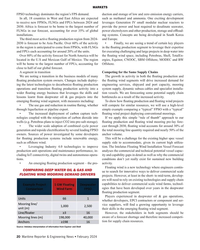 )
February 2024 - Maritime Reporter and Engineering News page: 20
)
February 2024 - Maritime Reporter and Engineering News page: 20the region’s FPS demand. duction and storage of low and zero emission energy carriers, In all, 18 countries in West and East Africa are expected such as methanol and ammonia. One exciting development to receive new FPSOs, FLNGs and FPUs between 2024 and leverages Generation IV small modular nuclear reactors
-
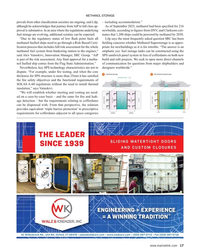 )
February 2024 - Maritime Reporter and Engineering News page: 17
)
February 2024 - Maritime Reporter and Engineering News page: 17METHANOL STORAGE provals from other classi? cation societies are ongoing, said Lilp, – including accommodation.” although he acknowledges that journey from AiP to full class ap- As of September 2023, methanol had been speci? ed for 216 proval is substantive. In an area where the regulations underlying
-
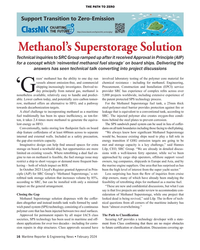 )
February 2024 - Maritime Reporter and Engineering News page: 16
)
February 2024 - Maritime Reporter and Engineering News page: 16THE PATH TO ZERO Methanol’s Superstorage Solution Technical inquiries to SRC Group ramped up after it received Approval in Principle (AIP) for a concept which ‘reinvented methanol fuel storage’ on board ships. Delivering the answers has seen technical talk converting into project discussions
-
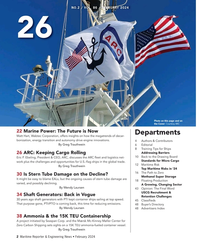 )
February 2024 - Maritime Reporter and Engineering News page: 2
)
February 2024 - Maritime Reporter and Engineering News page: 2ships in the global trade. 12 Maritime Risk By Greg Trauthwein Top Maritime Risks in ‘24 16 The Path to Zero 30 Is Stern Tube Damage on the Decline? Methanol Super Storage It might be easy to blame EALs, but the ongoing causes of stern tube damage are 18 Floating Production varied, and possibly declining
-
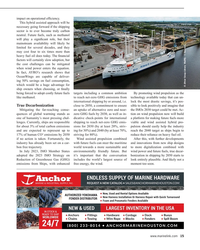 )
January 2024 - Maritime Reporter and Engineering News page: 15
)
January 2024 - Maritime Reporter and Engineering News page: 15. This hybrid assisted approach will be necessary going forward if the shipping sector is to ever become truly carbon neutral. Future fuels, such as methanol will play a signi? cant role, but their mainstream availability will likely be limited for several decades, and they may cost four to six times
-
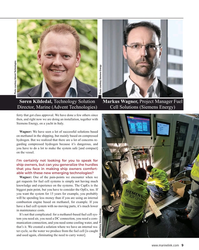 )
January 2024 - Maritime Reporter and Engineering News page: 9
)
January 2024 - Maritime Reporter and Engineering News page: 9right now we are doing an installation, together with Siemens Energy, on a yacht in Italy. Wagner: We have seen a lot of successful solutions based on methanol in the shipping, but mainly based on compressed hydrogen. But we realized that there are a lot of concerns re- garding compressed hydrogen because
-
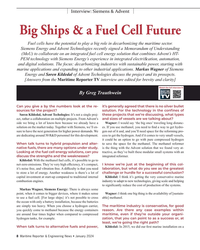 )
January 2024 - Maritime Reporter and Engineering News page: 8
)
January 2024 - Maritime Reporter and Engineering News page: 8already have a Wagner: I would say ‘the big ones’ traveling long distanc- solution on the market today. Together with Siemens, we’ll en- es. If you use methanol, you need to fnd a way to get hydro- sure to have the next generation for higher power demands. We gen out of it and, and you’ll need space for the
-
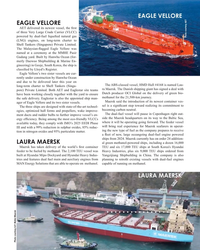 )
December 2023 - Maritime Reporter and Engineering News page: 39
)
December 2023 - Maritime Reporter and Engineering News page: 39shipping giant has signed a deal with have been working closely together with the yard to ensure Dutch producer OCI Global on the delivery of green bio- methanol for the 21,500-km journey. the safe delivery. Eaglestar is also the appointed ship man- Maersk said the introduction of its newest container ves- ager
-
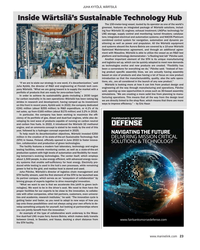 )
December 2023 - Maritime Reporter and Engineering News page: 23
)
December 2023 - Maritime Reporter and Engineering News page: 23, while also de- veloping its next wave of products capable of running on carbon neutral and carbon free fuels. In 2022, it introduced the Wärtsilä 32 methanol engine, and an ammonia concept is slated to be ready by the end of this year, followed by a hydrogen concept expected in 2025. NAVIGATING THE FUTURE
-
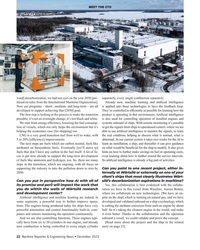 )
December 2023 - Maritime Reporter and Engineering News page: 22
)
December 2023 - Maritime Reporter and Engineering News page: 22weeks for the AI to The next steps are fuels which are carbon neutral, fuels like learn an installation, a ship, and thereafter it can give guidance methanol on biosynthetic basis. Eventually [we’ll move to] on what would be bene? cial for the ship to modify. It also gives fuels that don’t have any carbon
-
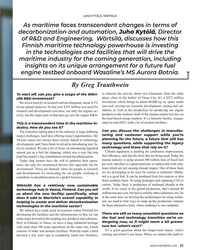 )
December 2023 - Maritime Reporter and Engineering News page: 21
)
December 2023 - Maritime Reporter and Engineering News page: 21not causing climate impact. One of those fuels and development; it’s motivating for our people, working to we are developing to be used for marine is methanol. Metha- nol is a good fuel. It can be produced from bio sources or also contribute to decarbonization in a global business. from synthetic basis
-
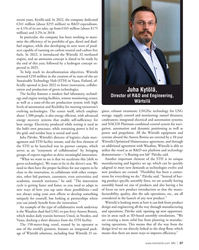 )
November 2023 - Marine News page: 57
)
November 2023 - Marine News page: 57, while also developing its next wave of prod- ucts capable of running on carbon neutral and carbon free fuels. In 2022, it introduced the Wärtsilä 32 methanol engine, and an ammonia concept is slated to be ready by the end of this year, followed by a hydrogen concept ex- pected in 2025. To help reach its
-
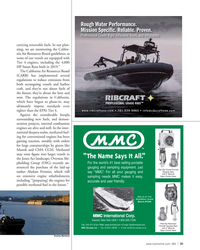 )
November 2023 - Marine News page: 31
)
November 2023 - Marine News page: 31hoopla surrounding new fuels, and demon- stration projects, internal combustion engines are alive and well. In the inter- national deepsea realm, methanol fuel- ing for conventional engines has been gaining traction, notably with orders for large containerships by giants like Maersk and CMA CGM. Methanol
-
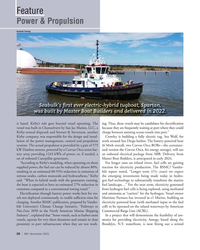 )
November 2023 - Marine News page: 28
)
November 2023 - Marine News page: 28For the near term, electricity generated emissions compared to a conventional towing vessel.” from hydrogen fuel cells is being explored, using methanol Electri? cation through battery power works best for ves- and ammonia as “carriers” for the hydrogen. Vessel owner sels not deployed continuously
-
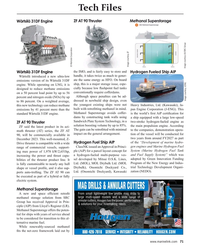 )
November 2023 - Maritime Reporter and Engineering News page: 71
)
November 2023 - Maritime Reporter and Engineering News page: 71Tech Files Wärtsilä 31DF Engine ZF AT 90 Thruster Methanol Superstorage © Wärtsilä Corporation Image courtesy ZF Image courtesy LR/SRC Group the IMO, and is fairly easy to store and Wärtsilä 31DF Engine Hydrogen Fueled Ship AIP Wärtsilä introduced a new ultra-low handle, it takes twice as much to
-
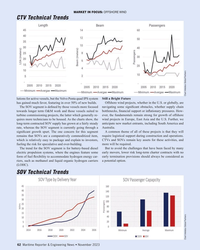 )
November 2023 - Maritime Reporter and Engineering News page: 62
)
November 2023 - Maritime Reporter and Engineering News page: 62with no form of fuel ? exibility to accommodate hydrogen energy car- early termination provisions should always be considered as riers, such as methanol and liquid organic hydrogen carriers a potential option. (LOHC). SOV Technical Trends Chart Intelatus Global Partners Chart Intelatus Global Partners 62
-
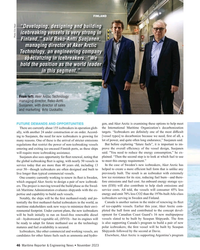 )
November 2023 - Maritime Reporter and Engineering News page: 46
)
November 2023 - Maritime Reporter and Engineering News page: 46less pertise and capability to build such vessels. energy and emit 70% less CO2 than the 1970s-built Atle-class Notably, the ships will be the ? rst methanol-ready and po- icebreakers serving in Sweden and Finland. tentially the ? rst methanol-fueled icebreakers in the world, as Canada is another nation
-
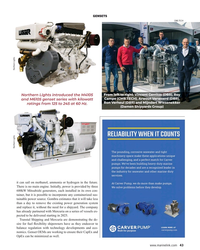 )
November 2023 - Maritime Reporter and Engineering News page: 43
)
November 2023 - Maritime Reporter and Engineering News page: 43Ron Verheul (DBR) and Mijndert Wiesenekker ratings from 125 to 245 at 60 Hz. (Damen Shipyards Group) Northern Lights Northern Lights it can sail on methanol, ammonia or hydrogen in the future. There is no main engine. Initially, power is provided by three 600kW Mitsubishi generators, each installed in
-
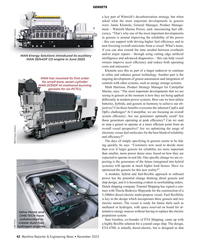 )
November 2023 - Maritime Reporter and Engineering News page: 42
)
November 2023 - Maritime Reporter and Engineering News page: 42of genset automation and integration of for small-bore, seven-cylinder controls with other systems, such as energy storage systems. MAN 21/31DF-M methanol-burning Mark Harrison, Product Strategy Manager for Caterpillar gensets for six PCTCs. Marine, says: “The most important developments that we are
-
 )
November 2023 - Maritime Reporter and Engineering News page: 41
)
November 2023 - Maritime Reporter and Engineering News page: 41aboard large marine mer- chant vessels.” Other OEMs also have new fuel developments on-going. CMB.TECH & DBR HHI-EMD has developed a 4-stroke HiMSEN methanol en- Marine dual fuel gine, and Caterpillar Marine is designing alternative-fuel hydrogen genset gensets with a current focus on methanol. Yanmar
